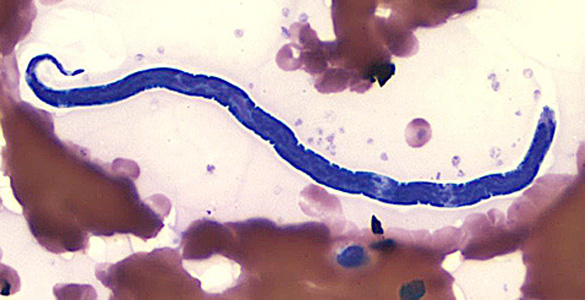Loa loa
| style="background:#Template:Taxobox colour;"|Template:Taxobox name | ||||||||||||||||
|---|---|---|---|---|---|---|---|---|---|---|---|---|---|---|---|---|
 | ||||||||||||||||
| style="background:#Template:Taxobox colour;" | Scientific classification | ||||||||||||||||
| ||||||||||||||||
| Binomial name | ||||||||||||||||
| Loa loa (Cobbold, 1864)[verification needed] | ||||||||||||||||
| Synonyms | ||||||||||||||||
|
Filaria loa Cobbold, 1864 |
|
Loa Loa Filariasis Microchapters |
|
Diagnosis |
|---|
|
Treatment |
|
Case Studies |
|
Loa loa On the Web |
|
American Roentgen Ray Society Images of Loa loa |
Editor-In-Chief: C. Michael Gibson, M.S., M.D. [1]
Overview
Loa loa is the filarial nematode (roundworm) species that causes Loa loa filariasis. It is commonly known as the "eye worm". Its geographic distribution includes Africa and India.[1]
L. loa is one of three parasitic filarial nematodes that cause subcutaneous filariasis in humans. The two other filarial nematodes are Mansonella streptocerca and Onchocerca volvulus (causes river blindness).
Maturing larvae and adults of the "eye worm" occupy the subcutaneous layer of the skin – the fat layer – of humans, causing disease. The young larvae develop in horseflies of the genus Chrysops (deer flies, yellow flies), including the species C. dimidiata and C. silacea, which infect humans by biting them.
Biology
Morphology
Loa loa worms have a simple body including a head, body, and tail. Males range from 20mm to 34mm long and 350μm to 430μm wide. Females range from 20mm to 70mm long and are about 425μm wide.[1]
Life cycle
Three species involved in the life cycle include the parasite Loa loa, the fly vector, and the human host:[2]
- A vector fly bites an infected human host and ingests microfilariae.
- Microfilariae move to the fat body of the insect host.
- Microfilariae develop into first stage larvae, second stage, then third stage larvae.
- Third stage larvae (infective) travel to the proboscis of fly.
- An infected vector fly bites an uninfected human host and the third stage larvae penetrates the skin and enters human subcutaneous tissue.
- Larvae mature into adults, who produce microfilariae that have been found in spinal fluid, urine, peripheral blood, and lungs.
Disease
Pathogenesis
Loa loa parasites infect human hosts by travelling from the entry site through subcutaneous tissues and causing inflammation in the skin wherever they travel. If a parasite stops in one place for a short period of time, the human host will suffer from local inflammation known as Calabar swellings. These are localized, tense, inflammatory pruritic subcutaneous edema seen in joints of extremities, lasting for 1–3 days. They represent areas of angioedema resulting from a host response to allergens released by the maturating worm and its metabolic products.[3] Calabar swellings often occur in the wrist and ankle joints but disappear as soon as the parasite begins to move again. Parasites can also travel through and infect the eye, causing the swelling of the eye. Common symptoms include itching, joint pain, fatigue, and death.[1]
Diagnosis and treatment
The main methods of diagnosis include the presence of microfilariae in the blood, the presence of a worm in the eye, and the presence of skin swellings. Surgical removal of the worm can easily be performed. The common treatment for the disease is the use of the drug Ivermectin.[1]
Ivermectin has become the most common antiparasitic agent used worldwide but can lead to residual microfilarial load when given in the management of loiasis. High microfilarial loads should be decreased by a course of ivermectin, a prolonged administration of albendazole, or cytapheresis sessions to prevent occurrence of serious adverse events, including fatal encephalopathy induced by dying microfilariae. Cytapheresis is helpful in decreasing very high microfilarial loads up to 75%. Diethylcarbamazine kills both microfilariae and adult worms but has more severe side effects and can be fatal.
References
- ↑ 1.0 1.1 1.2 1.3 Schmidt, Gerald et al. "Foundations of Parasitology". 7th ed. McGraw Hill, New York, NY, 2005.
- ↑ "Filariasis". Parasites and Health. Center for Disease Control.
- ↑ Rivière, E., Kerautret, J., Combillet, F., & Malvy, D. (2012). African Eye Worm. Journal Of Global Infectious Diseases, 4(2), 135-136. doi:10.4103/0974-777X.96782
- Taxonomy Browser: Loa Loa. National Center for Biotechnology Information (NCBI).